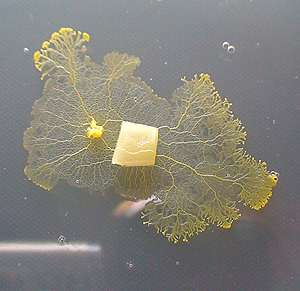October 9, 2012 report
Study shows slime molds have spatial memory

(Phys.org)—Biology researchers from the University of Sydney, working with colleagues from Paul Sabatier Université in Toulouse have found that the brainless slime mold Physarum polycephalum, is able to use its slime trail as a memory device. In their paper published in the Proceedings of the National Academy of Sciences, the team describe how they used a baited trap to test the molds' ability to navigate around an obstacle both when able to use its trail as a guide, and when its trail was disguised, to uncover how the mold uses the trail as a memory device.
P. polycephalum is a simple creature, made up of just one cell. It has no brain, nor neural system, yet is able to move about in its environment without retracing its steps. How it has been able to accomplish this feat has remained a mystery, until now.
The key to solving the problem lies in how the mold moves around and in the makeup of the slime trail it leaves behind. P. polycephalum has several different parts, or areas that make up its body, each of which respond independently to its environment. The different parts expand and contract, pulsating at a certain rate depending on what is being experienced. Heat, food or light cause changes in the pulsation rate which differ from the rate of other parts of the molds' body. These differences in pulsation rates are what cause the mold to move. As the mold moves, a layer of slime is deposited beneath its body to allow for sliding across surface material. Chemicals in the slime also cause changes in the pulsation rate, which accounts for how they can avoid treading on it.
Suspecting that the mold was somehow using its slime trail as a memory device, the team ran two experiments involving traps. The first involved placing a mold in trap with a Y shaped obstacle with food placed at each end of the branch. When a slime mat was placed in the path between the mold and the food source, 39 out of 40 test slime went all the other way around to get at it.
In the second experiment, the molds were placed in a trap where a U shaped obstacle was placed between the mold and a food source. As the molds made their way to the food, they were timed to see how long it took them to get around the obstacle. Two types of trials were run, the first was where the molds were allowed to move on a normal surface. In the second, the surface was covered with slime similar to that produced by the mold, preventing the mold from using it as a memory device. When the molds were allowed to use their trails, 96 percent of them reached the food within 120 hours. That number shrank to just 33 percent when left to navigate without use of their trail.
These results indicate that P. polycephalum uses its slime trail as a memory device, the first example of that ability in an organism with no brain.
More information: Slime mold uses an externalized spatial "memory" to navigate in complex environments, PNAS, Published online before print October 8, 2012, doi: 10.1073/pnas.1215037109
Abstract
Spatial memory enhances an organism's navigational ability. Memory typically resides within the brain, but what if an organism has no brain? We show that the brainless slime mold Physarum polycephalum constructs a form of spatial memory by avoiding areas it has previously explored. This mechanism allows the slime mold to solve the U-shaped trap problem—a classic test of autonomous navigational ability commonly used in robotics—requiring the slime mold to reach a chemoattractive goal behind a U-shaped barrier. Drawn into the trap, the organism must rely on other methods than gradient-following to escape and reach the goal. Our data show that spatial memory enhances the organism's ability to navigate in complex environments. We provide a unique demonstration of a spatial memory system in a nonneuronal organism, supporting the theory that an externalized spatial memory may be the functional precursor to the internal memory of higher organisms.
Journal information: Proceedings of the National Academy of Sciences
© 2012 Phys.org

















